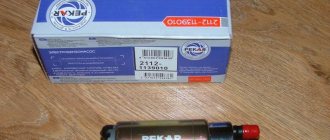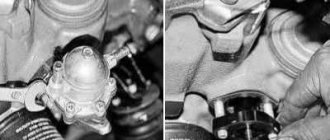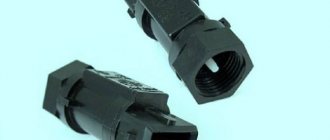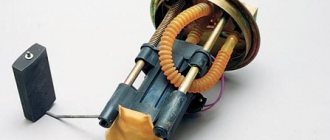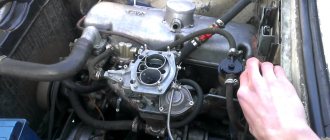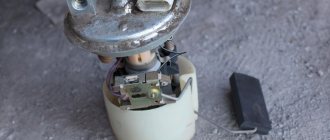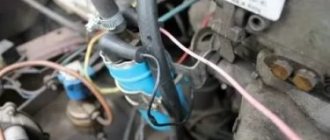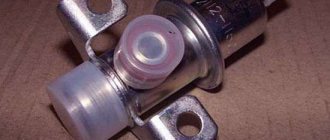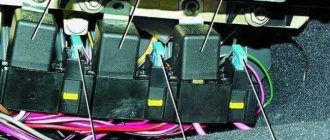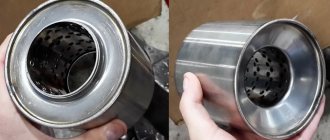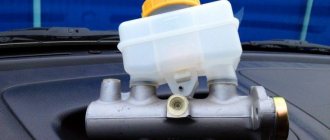Home » Repair tips » Replacing the fuel pump yourself - video 661
You can replace the fuel pump yourself; this malfunction is completely unpleasant, since the car will not even move without it.
Everyone believes that the main part of any car is the engine. One can argue with this, since the engine is rather the driving force of the car, and the heart, without any doubt, will be the fuel pump. Once it malfunctions, breaks down, the whole car will look like a pile of iron. After all, we must admit that you can come to the nearest car service center even with a broken cylinder, or if the radiator in the car is broken.
If the driver has even the slightest idea how to fix this. But if the fuel pump doesn’t work, it’s a big deal. The only thing that can help here is a tow truck or towing with another car. True, popular rumor says that there are specialists who managed to connect the windshield washer reservoir to the fuel system, poured fuel into it, and then slowly drove to the nearest workshop. But this is more of a fantasy and repeating such manipulations is extremely dangerous both for the life of the driver and for the car itself. So, let's talk about in what cases the fuel pump needs to be replaced.
Where is the fuel pump located, the purpose of the device
The location of the device responsible for the uninterrupted delivery of energy in operating mode depends on its type. Mechanical ones are used on cars with carburetors, and also as an auxiliary system for diesel vehicles. To create an active and at the same time effective vacuum, the function of controlling the fuel pumping mode is transferred to the engine camshaft. Even car owners who do not have special knowledge will always accurately tell you where the mechanical fuel pump is located. When troubleshooting or replacing this unit, look for this unit in the area where the engine is located.
Electrically driven fuel delivery systems are driven directly from the battery or generator. This removes the restriction on the location of this element. Depending on the designer’s design, superchargers can be located in the fuel tank area or in the engine compartment. The design of the fuel pump depends on a number of factors. These include the assigned functions, expected dynamics and engine power.
Location
For a variety of reasons, it was impossible to place an electric fuel pump on the engine. In this case, first of all, it is impossible to ensure sufficient performance, which means that one of the purposes of the gasoline pump will not be fulfilled - creating high pressure. In addition, installation on the engine was necessary to provide mechanical drive, but when using an electric motor, this was no longer necessary. Therefore, the designers placed the gas pump in the fuel tank of the car.
Changing the location allowed us to solve several problems at once:
- The pump turned out to be submersible. Thus, there is no need to pump gasoline through the fuel line, which significantly increases the outlet pressure.
- The problem of cooling the electric motor has disappeared. Heat is removed by the fuel in which the fuel pump windings are located. The fact is that gasoline has a very low conductivity, which allows the electric motor to operate while completely immersed in liquid. Any sparking during pump operation is completely excluded, so all fire safety rules are observed.
- In addition to its main purpose and cooling, gasoline acts as a kind of sound insulation. The electric motor immersed in it is almost inaudible inside the car.
Cooling the pump with gasoline also has one significant disadvantage. It is always necessary to have a reserve of fuel in the tank. If the gasoline runs out, which often happens with inexperienced motorists, the electric motor will most likely fail.
The fuel pump in the fuel tank is a design typical for all injection engines. This remains the same for any manufacturer. At the same time, the place where the fuel pump is located and how to get to it depends on the make of the car. In most cases, access is sufficient by removing the rear seats.
Features of fuel pumps
The distinctive properties of energy supply systems depend on the structural assembly. The drive unit contains rotary and gear pumps. Centrifugal devices typical for foreign cars should be looked for in the gas tank. The classification often uses a division into remote mechanisms that are mounted directly on the car body. Submersible structures are used inside tanks. With this design of the fuel pump, cooling of the moving parts is ensured and cases of idling are prevented. Additionally, the design of the supercharger includes sensors responsible for monitoring the level of gasoline and pressure in the supply system.
Unlike mechanical ones, electric models receive a signal to operate not from the camshaft, but from the engine control unit. A special relay is responsible for turning it on, which works synchronously with the ignition system. The pressure in the injection system can reach 0.4 MPa for gasoline and 0.7 MPa for diesel engines.
Car won't start after replacement
Car won't start after replacing fuel pump? This phenomenon is not uncommon. In many cases, this is not a problem. The car cannot start immediately because the pump takes time to pump up the pressure that was previously reduced. To bring the pressure to the optimal level, you need to turn on the ignition for 5 seconds so that the instrument panel lights up. Next, turn the engine with the starter. If it doesn't work on the first try, you should wait about a minute and try again.
If cranking the starter does not help start the engine, then one of the following reasons may be occurring:
- errors were made when assembling or connecting the BN;
- the new fuel module is faulty;
- the car's security system has gone down or a blockage has occurred;
When installing and connecting a new pump, failures of various types are possible: from malfunction of the valves on the fuel pump to breakage of contacts, terminals or connectors.
It is important to identify the exact nature of the problem and determine its type - electrical or mechanical. The simplest breakdown relates to the power supply to the fuel pump; it either exists or it doesn’t. If we are talking about an immobilizer or alarm system, then the anti-theft system can turn off the power supply to the BN, preventing the car from starting. Don't forget about filter clogging either. If the valves are stuck, the device can operate and produce characteristic sounds, but at idle.
The listed malfunctions prevent fuel from entering the ramp, so the engine cannot start. To clearly determine the cause, it is important to make sure that there is no gasoline in the rail. Next, it is recommended to dismantle and connect the BN from the dimensions or batteries directly. This method is considered the fastest for checking the device.
Fuel pump design
Despite many years of experience in the automotive industry, designers use various designs of energy injection mechanisms. The answer to such questions as the injection pump (high pressure fuel pump), what it is and what functions it performs, lies in the design of the units.
In the classification of the main components of fuel injection systems, the following modifications are distinguished:
- Vacuum mechanisms. Created on the basis of mechanical devices, the drive is replaced by an electric one;
- Plunger models. Rare in design, most often these are fuel pumps with high-pressure injectors for diesel engines;
- The use of centrifugal force is actively used in elements of the same name, which have an impressive service life;
- Roller and gear devices pump gasoline and other fuels due to the vacuum of the moving elements. They are distinguished by stable supply indicators.
Mechanical fuel pumps
Until the advent of new generation electric drive models, these modifications remained the mainstay for supplying carbureted engines. Driven through eccentric camshaft cams, they ensured the expected injection accuracy in dosage and timing. Alternative models of mechanical fuel pumps received their impulse from the oil pump.
The device contents are as follows:
- Pushrod with drive cam and lever;
- Pushrod return spring;
- Diaphragm of the movable drive on the rod;
- Suction and discharge valve system;
- Filter element;
- Hull part.
The basic operating principle of a mechanical fuel pump is based on a system that ensures the creation of vacuum and subsequent pressure control. Disadvantages include the need to specify settings (calibration) and partial loss of engine power. The second problem was subsequently solved by redistributing the load from the engine camshaft to the oil pump.
How to check the operation of a mechanical fuel pump
The smooth movement of the car depends on the serviceability of this part. If the pump completely fails, the car simply will not start or the engine will start with difficulty. The malfunction can be detected at idle speed, when the so-called “floating speed” appears. Also, failure of the mechanical fuel pump causes a noticeable loss of dynamics.
Considering that the supercharger is a complex device, serviceability checks are carried out in the following areas:
- Pump terminal voltage;
- Fuse;
- Standard pressure in the ramp.
If it is not possible to identify a malfunction based on external signs, the breakdown has occurred within the assembly. In this case, a complete replacement of the unit is most often recommended.
Electrically Driven Fuel Pumps
The main purpose of pulse-controlled systems is to ensure the operating cycle of engines with distributed fuel injection. The question of what an electric gasoline pump is is quite extensive, since almost the entire arsenal of technologies is used to distribute the liquid working medium. Vacuum, roller and even vortex devices, each of these mechanisms is selected for the type directly by the car designer.
How to check the functionality of an electric pump
The causes of failure of the fuel system pressure generator are similar to symptoms for mechanical devices. Loss of dynamics, intermittent movement - wear of the fuel pump is detected by the operating principle. At the first stages of the service, the filter is replaced and the fuse is checked for functionality. Also, during a survey of the car owner, the habit of driving with a small amount of fuel may be revealed, as a result of which the unit runs “dry”, subject to increased wear.
How to replace the mesh in the fuel pump
This procedure is very typical for almost all car models and may differ only in minor details. The differences may only relate to the design features of the car, but according to the general principle, replacing a fuel pump mesh is the same almost everywhere. After all, the main goal is one thing - you need to ensure that the ride of your car is smooth and without jerking. You can see how to replace the mesh in the fuel pump in this article.
First, it should be noted that when you visually inspect the fuel pump mesh, you may not immediately see obvious signs of contamination. But in any case, this part will need to be changed, even if at first glance it seems clean and without defects. Moreover, the cost of this part is so low that purchasing a mesh for a gas pump will not cause serious damage to your wallet. And even if the reason why your car suddenly lost its smooth running has nothing to do with this part, then after a while it will still have to be replaced. So why not do this right away? So there is no need to neglect this process, especially since replacing the fuel pump mesh will not take you much time, because you have already removed the pump itself, which means half the job is done. And you can easily do this on your own. As the video shows, to do this it is enough to act clearly and carefully.
Main malfunctions and service life of fuel pumps
The average service life of key system elements is 200,000 kilometers. The resource can be compared with the overhaul interval of a gasoline engine with a fuel injection pump, when the car requires complex intervention. The main malfunctions of pumps for supplying and maintaining pressure in the system can be classified in two areas:
- Violations in the control unit. The unit receives incorrect signals, which directly affects the responsiveness of the car when driving;
- Mechanical wear of individual parts. Due to the rather complex circuit of the fuel pump, it is unsuitable for restoration (disassembly and diagnostics will be expensive). It’s easier and cheaper to buy a new part for later replacement.
How to change a gasoline pump on carburetor engines
The procedure for replacing a fuel pump on carburetor cars is not complicated. First, you need to turn off the engine and let it cool to make repairs more comfortable. Then perform simple manipulations:
- Remove the hoses from the inlet and outlet of the fuel pump.
- Unscrew the two nuts that secure the pump housing to the motor.
- Carefully remove the housing.
- Remove the pump rod and remove the old gaskets.
Reassemble in the reverse order, change the rod if necessary and install a sufficient number of gaskets. It is important that the rod protrudes no more than 1.2 mm above the surface.
Classification and design of fuel injection pump
Pump sections that provide high fuel pressure for a diesel engine are of three types:
- In-line mechanisms - plunger pairs for each cylinder;
- Distribution, for passenger cars, more compact;
- Main line, used in fuel supply systems.
The latest type of fuel injection pump belongs to a new generation of systems and is controlled by a computer. An injection engine should not be confused with a high-pressure fuel pump, since this is primarily an injection system.
Depending on the type of plunger drive, fuel pumps are pneumatic, hydraulic and mechanical.
What problems can you expect when replacing a fuel pump?
The main problem that can await a car enthusiast who decides to replace the fuel pump on his own is that the result, contrary to what was expected, may be negative. The fuel supply is still interrupted or not at all. To prevent this from happening, before starting the work described above, make sure that the problem was in the fuel pump and not in something else. It is necessary to remember that if you have low pressure in your car and the fuel flows intermittently, then the fine filter may simply be clogged, or the fuel lines are bent, or the injectors located on the fuel rail are clogged. Even if you did not replace the air filter on time or your throttle valve is coked, any of these malfunctions will be similar to a malfunction of the fuel pump. But as the video shows, the most common problem that occurs in this case is insufficient contacts in the electrical block, which is installed on the fuel pump, or the fuse has simply blown.
Multi-plunger injection pumps and their design features
Each section of the system has special pushers. At the beginning of the power stroke, a certain amount of fuel enters the plunger through the inlet port. At the end of the stroke, the supply channel closes, the cylinder creates pressure under which fuel is pumped to the nozzle for subsequent spraying into the cylinder block.
Peculiarities:
- In a row arrangement, pairs of plungers are located side by side;
- With a V-shaped arrangement of cylinders, pairs of plungers are in two rows.
How distribution injection pumps work
The fuel pumps that replaced the carburetor engine have a longer service life and improved drive. Distribution systems often have one plunger, which provides efficient supply to the engine, but at the same time wears out quickly and requires service work.
The pusher drive is made in the form of a cam mechanism, rotary or mechanical. There are systems with external drive. When a push is received from the cam, the plunger is pushed upward with a subsequent increase in pressure. Thus, the high-pressure fuel pump supplies gasoline or diesel to the injectors through the distributor channel for subsequent delivery to the cylinder blocks.
Fuel pump for injection engine
Forced injection of fuel into the cylinders requires high pressure in the fuel system. The use of an additional pump for this would lead to a significant complication of the vehicle design. Therefore, it was necessary to completely change the existing one, while adhering to the following requirements:
- The pressure generated by the pump must be sufficient to operate the injectors.
- The need to operate in accordance with the commands of the electronic control unit.
- The pump must have high performance.
To meet all the requirements, we had to make the fuel pump electric. This allowed us to solve some of the problems. For greater efficiency, we had to change the location.
The fuel pump of an injection engine consists of the following elements:
- frame;
- stator winding;
- rotor with impeller;
- check and pressure relief valves;
- outlet fitting.
When describing the fuel pump, it is necessary to mention the coarse filter, the so-called mesh, which protects its components from the ingress of foreign particles.
Main fuel injection pumps of the Common Rail system
In such pumps, which work primarily with diesel engines, fuel is collected in a special ramp before being pumped into the injectors. The intermediate accumulator in the injection pump is used to generate sufficient pressure (but not excessive), as well as to compensate for losses caused by the failure of individual injectors. Depending on the required level of injection force, designers can install one, two or three plungers in such systems.
Methods for dispensing fuel into the injection pump
The cyclic supply of diesel, in contrast to injection and carburetor gasoline pumps, ensures more accurate energy consumption. Due to an additional device - a bypass valve, excess fuel is removed at excess pressure.
The classification uses three types of devices:
- With throttling at the moment of fuel intake;
- With cut-off function;
- With a combination of dosages.
Fuel volume control can be mechanical (spring) or electronic.
conclusions
Despite the fact that the pump is located so far from the driver, it must always be monitored. Firstly, change the filter in a timely manner. Secondly, clean the motor contacts from oxides. Please note that when the filter is clogged, the engine begins to work under greater load, sometimes it does not even have time to pump the required amount of gasoline into the ramp. And if you start everything up and allow the filter to collapse, then all the dirt will get into the injectors, which will immediately clog. Timely replacement of the fuel pump and filter will avoid such disastrous results.
Signs and causes of malfunction
The design of the injection pump remains a mechanism that is difficult to diagnose in a garage environment. Detection of faults occurs at special stands. Among a large group of factors that confirm problems with a main or other type of injection pump is the presence of foreign media in the system - water, fuel and contaminants. In practice, problems with the pump are identified by increased fuel consumption, engine overheating, a drop in dynamics and power, and an increase in the amount of smoke in the exhaust gases. The lack of injector activation will be indicated by difficulty starting the engine, interruptions in idling and increased noise while driving.
Fuel quality
In addition to failure to comply with maintenance intervals, another common reason that leads to fuel pump failure is gasoline. Not all gas stations have the same quality. Some of them violate transportation and storage rules. As a result of systematic refueling at such gas stations, a large number of foreign particles accumulate in the tank, which clog the fuel pump screen.
This is manifested by a loss of engine power, jerking of the car when driving and, oddly enough, excessive fuel consumption. You have to remove the fuel pump and service it. If this is not done, then it will become impossible to drive the car; fuel will simply stop flowing to the injectors. The reason for this is clearly visible in the photo of a fuel pump with a clogged screen.
Replacing the pump
To replace the fuel pump, you need to arm yourself with a set of tools. After this, proceed to dismantling:
- You fold down the rear seat and underneath there is a niche with a pump installed.
- Disconnect the block with wires.
- Remove the tubes and hoses that go to the fuel pump.
- Unscrew all the nuts that will secure the housing to the gas tank.
- Carefully remove the pump along with the fuel level sensor.
- Disconnect the pump from the fuel level sensor.
If it is not possible to replace the pump, repair it. To do this, as a rule, it is enough to install new brushes.
But it also happens that one or more windings on the rotor or stator fail. In this case, of course, it will be easier to install a new electric pump. But if you have suitable wire or working spare parts from old pumps, you can try to repair it. As a rule, this is quite difficult to do - the damage is usually so severe that the pump elements cannot be restored. Therefore, the best way out is to install a new or used device.
After repair work, everything must be reassembled in the reverse order. And don’t forget to install a rubber gasket, otherwise gasoline will start leaking out. When replacing the fuel pump mesh, you will have to perform similar manipulations, but you do not need to install a new electric drive.
